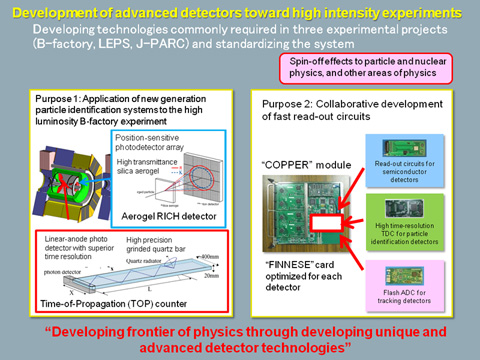Detector Development
Research Project D01: Development of frontier detectors for intensity frontier experiments
In the D01 program, we develop frontier detectors for future intensity frontier experiments in this research project, under collaboration of researchers from the three experimental teams, B-factory (A01), LEPS (B01) and J-PARC-E16 (C01). Especially, we focus on development of particle identification (PID) detectors and high-speed readout systems, which are commonly important for the three experiments.
For the PID detectors, we are developing two types of next-generation PID detectors, called “TOP counter” and “Aerogel-RICH”, for the future high luminosity B-factory experiment. The TOP (Time-Of-Propagation) counter utilizes total internal reflection of Cherenkov photons produced in an accurately polished quartz bar. PID is performed by measuring the time of propagation of each photon with precision less than 50 ps by using an array of newly developed micro-channel-plate PMT (MCP-PMT). The TOP counter has been developed based on original idea provided by the team at Nagoya University. The Aerogel-RICH uses highly transparent silica aerogel radiator with refractive index (n) around 1.05. Cherenkov photons produced in aerogel are directly detected by array of photodetectors placed in parallel to the radiator. For Aerogel-RICH, we have successfully improved the optical transparency of hydrophobic aerogels. Under this research program, we aim at constructing and installing the TOP counter and Aerogel-RICH for the upgrade of the B-factory experiment at KEK, and establishing the new PID technologies. We will also investigate possible application of the new technologies to the experiments at Spring-8 and J-PARC.
As for the high-speed readout system, a pipeline readout system called “COPPER” has been developed for the future high intensity B-factory experiment. In this research program, we plan to develop digital processing boards for silicon vertex detector, tracking chambers and PID detectors, compatible to the COPPER system, by collaboration of three experiments. The developed system can be used commonly in related experiments.
Development of such new technologies will bring improvement of experiments at future high intensity accelerators, and lead to new physics results. In the fields of particle and nuclear physics, frontier detectors often bring frontier physics results. Also in this project, we hope that the development of new detector technologies will bring new findings in hadron physics.







